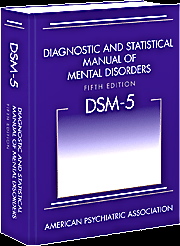In cities and towns throughout the US there are alienated teenagers and adults living unproductive lives and staying stoned on weed. Excessive cannabis use is a response to their situation(s) and prospects —a symptom of a disordered life, widespread in this era of social breakdown, but not a disorder in and of itself. So says me, an editor trying to apply accurate terminology.
The Diagnostic and Statistical Manual of the American Psychiatric Association —known as “The Bible” of the profession— says otherwise.
The DSM has a double purpose: it endows the field of Psychiatry with a facade of rigor and it facilitates billing.
The DSM defines and assigns a number to every ailment of the mind and spirit for which psychotherapists provide treatment, physicians prescråibe medication, and insurance companies reimburse.
The first DSM, published in 1952, listed 106 disorders. By increasing the number of disorders and the broadness of the definitions over the years, the DSM authors —establishment psychiatrists with drug-company funding— have increased the number of Americans who qualify for prescription drugs (and, fortuitously, for medical marijuana).
“Cannabis Abuse” is one of many conditions defined by the DSM under “Substance Related and Addictive Disorders.” The other substances said to give rise to “addictive disorders” are alcohol, caffeine, hallucinogens (phencyclicine and others), inhalants, opioids, sedatives (hypnotics or analgesics), stimulants, and tobacco.
DSM-V says, “The diagnosis of a substance use disorder is based on a pathological pattern of behaviors related to use of the substance.” Nine such behaviors are listed. They are listed below, with my retrograde messages in boldface:
“Criterion 1: The individual may take the substance in larger amounts or over a longer period than was originally intended.”
• If you try marijuana and find that it agrees with you, you may use it more than originally intended. How is that evidence of pathology?
“Criterion 2: The individual may express a persistent desire to cut down or regulate substance use and may report multiple unsuccessful efforts to decrease or discontinue use.”
• If a parent (or boss, counselor, or other authority figure) says marijuana is dangerous and you must stop using it, you may promise to stop. But when you’re among friends you’re re-convinced that it’s harmless (and even helpful), so you resume. According to the psychiatrists’ Bible, that is evidence of pathology. But it’s actually evidence of disobedience to the authority figure who pressured you to stop.
“Criterion 3: The individual may spend a great deal of time obtaining the substance.”
• That is a direct result of prohibition.
“Criterion 4: Craving is manifested by an intense desire or urge for the drug… more likely when in an environment where the drug previously was obtained or used.”
• The craving for cannabinoids is never “intense” compared to the craving for cigarettes or opiates. And it’s obvious you’ll be craving more when you’re around people who are indulging. Duh.
“Criterion 5: Recurrent substance use may result in a failure to fulfill major role obligations at work, school, or home.”
• This makes sense if the failure to fulfill is due to impairment, but it’s often due to punishment.
“Criterion 6: The individual may continue substance use despite having persistent or recurrent social or interpersonal problems caused or exacerbated by the effects of the substance.”
• Meaning: if people who disapprove of your cannabis use snub you, it’s your fault and evidence of pathology.
“Criterion 7: Important social, occupational, or recreational activities may be given up or reduced because of substance use.”
• Who decides that a given extra-curricular is “important?” Not the patient, obviously. Some people are like Ferdinand the Bull, they’d rather smell the flowers than play football.
Ferdinand the Bull, they’d rather smell the flowers than play football.
“Criterion 8: Recurrent substance use in situations in which it is physically hazardous.”
• Definitely a sign of stupidity.
“Criterion 9: The individual may continue substance use despite knowledge of having a persistent or recurrent physical or psychological problem that is likely to have been caused or exacerbated by the substance.”
• A drug can exacerbate a problem and produce benefit. Say a patient has chronic bronchitis, PTSD, and insomnia. They have a nightmare and wake up in a sweat. They take a few puffs of myrcene-rich marijuana, which can exacerbate bronchitis, but restores equanimity and makes sleep possible. A reasonable choice or evidence of pathology?
These psychiatrists play fast and loose with the language. —The managing editor




